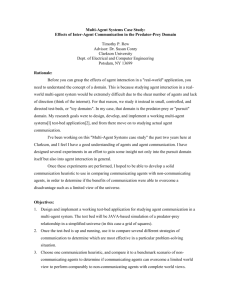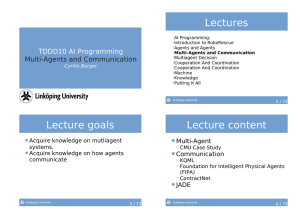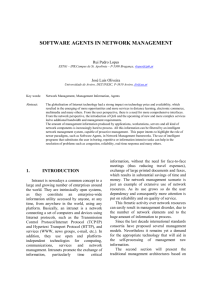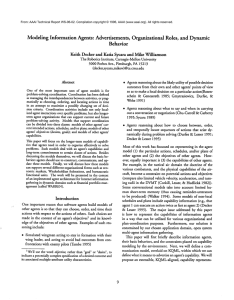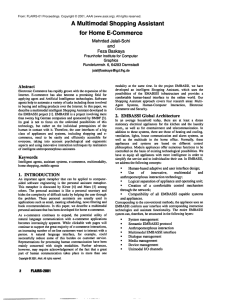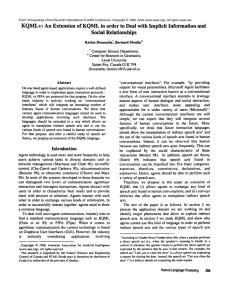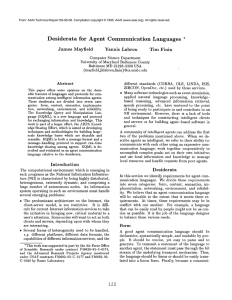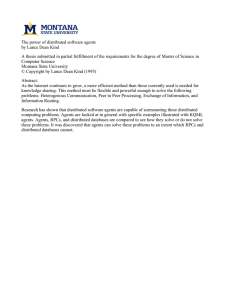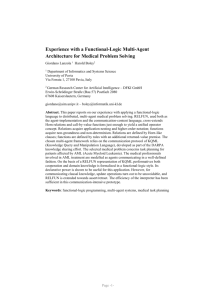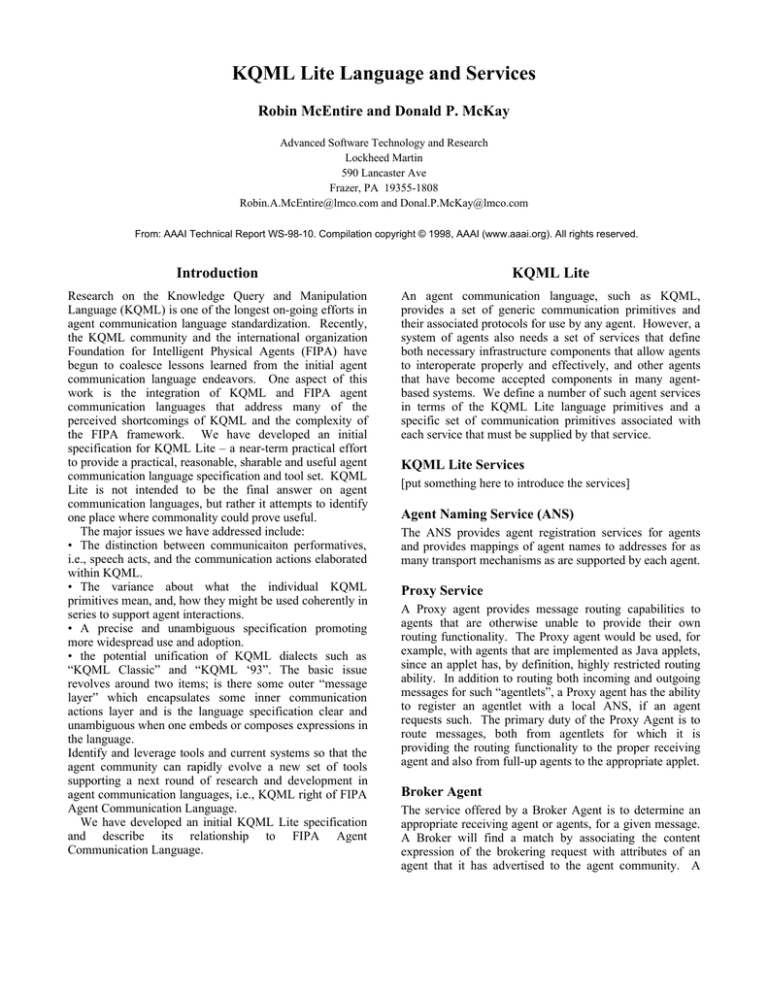
KQML Lite Language and Services
Robin McEntire and Donald P. McKay
Advanced Software Technology and Research
Lockheed Martin
590 Lancaster Ave
Frazer, PA 19355-1808
Robin.A.McEntire@lmco.com and Donal.P.McKay@lmco.com
From: AAAI Technical Report WS-98-10. Compilation copyright © 1998, AAAI (www.aaai.org). All rights reserved.
Introduction
KQML Lite
Research on the Knowledge Query and Manipulation
Language (KQML) is one of the longest on-going efforts in
agent communication language standardization. Recently,
the KQML community and the international organization
Foundation for Intelligent Physical Agents (FIPA) have
begun to coalesce lessons learned from the initial agent
communication language endeavors. One aspect of this
work is the integration of KQML and FIPA agent
communication languages that address many of the
perceived shortcomings of KQML and the complexity of
the FIPA framework. We have developed an initial
specification for KQML Lite – a near-term practical effort
to provide a practical, reasonable, sharable and useful agent
communication language specification and tool set. KQML
Lite is not intended to be the final answer on agent
communication languages, but rather it attempts to identify
one place where commonality could prove useful.
The major issues we have addressed include:
• The distinction between communicaiton performatives,
i.e., speech acts, and the communication actions elaborated
within KQML.
• The variance about what the individual KQML
primitives mean, and, how they might be used coherently in
series to support agent interactions.
• A precise and unambiguous specification promoting
more widespread use and adoption.
• the potential unification of KQML dialects such as
“KQML Classic” and “KQML ‘93”. The basic issue
revolves around two items; is there some outer “message
layer” which encapsulates some inner communication
actions layer and is the language specification clear and
unambiguous when one embeds or composes expressions in
the language.
Identify and leverage tools and current systems so that the
agent community can rapidly evolve a new set of tools
supporting a next round of research and development in
agent communication languages, i.e., KQML right of FIPA
Agent Communication Language.
We have developed an initial KQML Lite specification
and describe its relationship to FIPA Agent
Communication Language.
An agent communication language, such as KQML,
provides a set of generic communication primitives and
their associated protocols for use by any agent. However, a
system of agents also needs a set of services that define
both necessary infrastructure components that allow agents
to interoperate properly and effectively, and other agents
that have become accepted components in many agentbased systems. We define a number of such agent services
in terms of the KQML Lite language primitives and a
specific set of communication primitives associated with
each service that must be supplied by that service.
KQML Lite Services
[put something here to introduce the services]
Agent Naming Service (ANS)
The ANS provides agent registration services for agents
and provides mappings of agent names to addresses for as
many transport mechanisms as are supported by each agent.
Proxy Service
A Proxy agent provides message routing capabilities to
agents that are otherwise unable to provide their own
routing functionality. The Proxy agent would be used, for
example, with agents that are implemented as Java applets,
since an applet has, by definition, highly restricted routing
ability. In addition to routing both incoming and outgoing
messages for such “agentlets”, a Proxy agent has the ability
to register an agentlet with a local ANS, if an agent
requests such. The primary duty of the Proxy Agent is to
route messages, both from agentlets for which it is
providing the routing functionality to the proper receiving
agent and also from full-up agents to the appropriate applet.
Broker Agent
The service offered by a Broker Agent is to determine an
appropriate receiving agent or agents, for a given message.
A Broker will find a match by associating the content
expression of the brokering request with attributes of an
agent that it has advertised to the agent community. A
Broker may support one or more of the communication
primitives from the set of Brokering primitives, that define
behavior such as recommending, recruiting and brokering.
Management and Control Service
An Agent Manager/Controller has the ability to start, stop,
suspend and resume an agent or a system of agents. An
intelligent version of this agent could detect when agents
have ceased to respond to messages or has died, and, if
appropriate, restart an agent.
KB/DB Wrapper Service
A KB/DB Wrapper Agent services requests for access to a
data or knowledge store for the purpose of querying or
modifying that data or knowledge store.
Logging Service
A Logging Agent acts as a recipient for all incoming and/or
outgoing message traffice for an agent or agents.
Therefore, the content of a message sent to the logging
agent would be the complete KQML message that had been
received by, or sent out by, an agent. The Logging Agent
does not care about the semantics of the message that it
receives to be logged, and is only responsible for making
the logged message persistent.
Timings Service
A Timings Agent acts as a recipient of timings messages
from other agents. A timings message carries a description
of how much time was spent in defined sections of an agent
for processing a given message. Minimally, four times are
captured, namely;
1. Time spent reading an incoming message
2. Time spent processing an incoming message
3. Time spent writing an outgoing message
4. Time spent waiting for a response to a message (for
messages which have requested a reply)
Other times may be included in the timings message, which
comprises the content-level expression of the message sent
to the Timings Agent. These additional times may capture
application-level or API-level processing times.
Additional Agent Services
We consider the set of agent services described previously
to be an initial set that should be expanded as needs arise
and the experience of building agent-based systems grows.
Candidates for future additions to the current agent services
include:
• Conversation/Protocol Service
• Security Services
• Mobile Agent Docks
• Gateway Services (e.g., services that allow the
interoperation among agents using different agent
communication languages and/or protocols)
• Agent Debugging Services
• Various Mediation Services
Conclusions
We have developed a KQML agent tool kit based on a prior
specification of KQML, which encompasses these services
and features.
It has interoperable components and
interfaces in Java, C, C++, Common Lisp, and Perl. This
implementation has been licensed to nearly three dozen
research labs and universities worldwide. We expect to
have developed at least a Java implementation and Java
accessible services for KQML Lite by the time of the Tools
Workshop.
Acknowledgments. This work was funded under contract
to the Defense Advanced Research Projects Agency
(DARPA).

